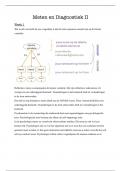DIGITAL METHODS (THEORY)
Marie De Rick & Britt Moens
(ook credits aan Victor Desmet)
2021-2022
,INHOUDSOPGAVE
1. digital methods: close reading, distant reading and common characteristics of big data 8
situating the course ............................................................................................................................................. 8
close reading (quali) ............................................................................................................................................ 9
distant reading (quanti) .................................................................................................................................... 10
readymade versus custommade data ............................................................................................................... 11
10 characteristics of big data sources ............................................................................................................... 11
big data ......................................................................................................................................................... 11
1. BIg.............................................................................................................................................................. 12
2. always-on .................................................................................................................................................. 13
3. nonreactive ............................................................................................................................................... 13
4. incomplete ................................................................................................................................................ 13
5. Inaccessible ............................................................................................................................................... 14
6. Nonrepresentative .................................................................................................................................... 14
7. Drifting ...................................................................................................................................................... 15
8. Algorithmically confounded ...................................................................................................................... 15
9. Dirty ........................................................................................................................................................... 16
10. sensitive .................................................................................................................................................. 16
Takeaways......................................................................................................................................................... 16
2. computational social science and open science 17
Computational communication science ............................................................................................................ 17
1. Opportunities of computational science for communication science ............................................................ 17
From self-report to real data ........................................................................................................................ 17
From self-report to real behavior. ................................................................................................................ 18
From lab experiments to studies of the actual social environment .............................................................. 21
From small-N to large-N ................................................................................................................................ 22
1
, From solitary to collaboratively .................................................................................................................... 24
2. challenges of computational science for communication science ................................................................. 25
Accessibility of data....................................................................................................................................... 25
Quality of big data (cf. lecture 1) .................................................................................................................. 26
Validity and reliability ................................................................................................................................... 26
Responsible and ethical conduct................................................................................................................... 28
Lacking skills and infrastructure .................................................................................................................... 29
3. Open science.................................................................................................................................................. 30
Computational social science, open science! ................................................................................................ 30
Why open science? ....................................................................................................................................... 30
conclusion.......................................................................................................................................................... 34
recap last week: open science ........................................................................................................................... 34
causes of the replication crisis ...................................................................................................................... 34
4. roadmap ........................................................................................................................................................ 35
Roadmap towards replicable computational social science ......................................................................... 35
Sharing your research design and hypotheses: preregistration ................................................................... 36
Sharing the data: open access to datasets .................................................................................................... 36
Make data reusable – reusable code! ............................................................................................................... 37
3. data visualization 38
Data visualization: Why?................................................................................................................................... 38
Are vaccinated persons more likely to be hospitalized for covid? ................................................................ 38
data science and data visualisation .................................................................................................................. 39
visual displays.................................................................................................................................................... 41
type of displays ............................................................................................................................................. 41
Cognitive Processing of data visualizations....................................................................................................... 42
cognitive processing ...................................................................................................................................... 42
2
, What happens when we see a visualization?................................................................................................ 43
attention ....................................................................................................................................................... 43
display schema .............................................................................................................................................. 44
domain knowledge ........................................................................................................................................ 44
Advantages of data visualization for cognitive tasks ........................................................................................ 45
why use visual displays? ................................................................................................................................ 45
cognitive science and principles of effective graphs ......................................................................................... 48
1. Do not trust your intuitions… .................................................................................................................... 48
2. Test the effectiveness of your display ....................................................................................................... 48
3. Task specificity .......................................................................................................................................... 49
Common uses of Graphs and visuals in computational science ........................................................................ 50
displays to illustrate data… ........................................................................................................................... 50
…But also displays to build algorithms .......................................................................................................... 50
4. Collecting data from the web – data scraping 51
intro ................................................................................................................................................................... 51
DATASCRAPING – WHAT IS THAT? .................................................................................................................... 52
COMMUNICATION SCIENCES EXAMPLES .......................................................................................................... 53
Example 1 ...................................................................................................................................................... 53
Example 2 ...................................................................................................................................................... 54
Example 3 ...................................................................................................................................................... 54
OFTENTIMES: ‘TEXT’ DATA GENERATED BY USERS ONLY.................................................................................. 55
COMMON APPLICATIONS .................................................................................................................................. 55
GENERAL PRINCIPLE .......................................................................................................................................... 57
DATASCRAPING….WHAT ARE THESE DATA THAT WE TALK ABOUT? BUILDING BLOCKS DATA, CODE &
FORMATS .......................................................................................................................................................... 58
Data, coding and data formats ...................................................................................................................... 58
3
Marie De Rick & Britt Moens
(ook credits aan Victor Desmet)
2021-2022
,INHOUDSOPGAVE
1. digital methods: close reading, distant reading and common characteristics of big data 8
situating the course ............................................................................................................................................. 8
close reading (quali) ............................................................................................................................................ 9
distant reading (quanti) .................................................................................................................................... 10
readymade versus custommade data ............................................................................................................... 11
10 characteristics of big data sources ............................................................................................................... 11
big data ......................................................................................................................................................... 11
1. BIg.............................................................................................................................................................. 12
2. always-on .................................................................................................................................................. 13
3. nonreactive ............................................................................................................................................... 13
4. incomplete ................................................................................................................................................ 13
5. Inaccessible ............................................................................................................................................... 14
6. Nonrepresentative .................................................................................................................................... 14
7. Drifting ...................................................................................................................................................... 15
8. Algorithmically confounded ...................................................................................................................... 15
9. Dirty ........................................................................................................................................................... 16
10. sensitive .................................................................................................................................................. 16
Takeaways......................................................................................................................................................... 16
2. computational social science and open science 17
Computational communication science ............................................................................................................ 17
1. Opportunities of computational science for communication science ............................................................ 17
From self-report to real data ........................................................................................................................ 17
From self-report to real behavior. ................................................................................................................ 18
From lab experiments to studies of the actual social environment .............................................................. 21
From small-N to large-N ................................................................................................................................ 22
1
, From solitary to collaboratively .................................................................................................................... 24
2. challenges of computational science for communication science ................................................................. 25
Accessibility of data....................................................................................................................................... 25
Quality of big data (cf. lecture 1) .................................................................................................................. 26
Validity and reliability ................................................................................................................................... 26
Responsible and ethical conduct................................................................................................................... 28
Lacking skills and infrastructure .................................................................................................................... 29
3. Open science.................................................................................................................................................. 30
Computational social science, open science! ................................................................................................ 30
Why open science? ....................................................................................................................................... 30
conclusion.......................................................................................................................................................... 34
recap last week: open science ........................................................................................................................... 34
causes of the replication crisis ...................................................................................................................... 34
4. roadmap ........................................................................................................................................................ 35
Roadmap towards replicable computational social science ......................................................................... 35
Sharing your research design and hypotheses: preregistration ................................................................... 36
Sharing the data: open access to datasets .................................................................................................... 36
Make data reusable – reusable code! ............................................................................................................... 37
3. data visualization 38
Data visualization: Why?................................................................................................................................... 38
Are vaccinated persons more likely to be hospitalized for covid? ................................................................ 38
data science and data visualisation .................................................................................................................. 39
visual displays.................................................................................................................................................... 41
type of displays ............................................................................................................................................. 41
Cognitive Processing of data visualizations....................................................................................................... 42
cognitive processing ...................................................................................................................................... 42
2
, What happens when we see a visualization?................................................................................................ 43
attention ....................................................................................................................................................... 43
display schema .............................................................................................................................................. 44
domain knowledge ........................................................................................................................................ 44
Advantages of data visualization for cognitive tasks ........................................................................................ 45
why use visual displays? ................................................................................................................................ 45
cognitive science and principles of effective graphs ......................................................................................... 48
1. Do not trust your intuitions… .................................................................................................................... 48
2. Test the effectiveness of your display ....................................................................................................... 48
3. Task specificity .......................................................................................................................................... 49
Common uses of Graphs and visuals in computational science ........................................................................ 50
displays to illustrate data… ........................................................................................................................... 50
…But also displays to build algorithms .......................................................................................................... 50
4. Collecting data from the web – data scraping 51
intro ................................................................................................................................................................... 51
DATASCRAPING – WHAT IS THAT? .................................................................................................................... 52
COMMUNICATION SCIENCES EXAMPLES .......................................................................................................... 53
Example 1 ...................................................................................................................................................... 53
Example 2 ...................................................................................................................................................... 54
Example 3 ...................................................................................................................................................... 54
OFTENTIMES: ‘TEXT’ DATA GENERATED BY USERS ONLY.................................................................................. 55
COMMON APPLICATIONS .................................................................................................................................. 55
GENERAL PRINCIPLE .......................................................................................................................................... 57
DATASCRAPING….WHAT ARE THESE DATA THAT WE TALK ABOUT? BUILDING BLOCKS DATA, CODE &
FORMATS .......................................................................................................................................................... 58
Data, coding and data formats ...................................................................................................................... 58
3



